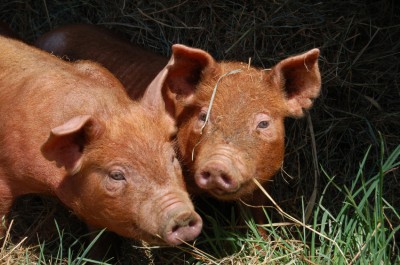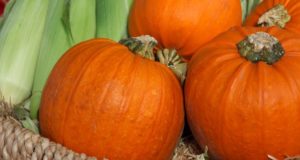Modern hog farming practices have given hog farming a bad name. The perception is that hog farming is dirty, muddy, and above all else, smelly. This perception discourages many homesteaders from giving pigs a try, but it doesn’t have to be that way. Today’s hog farming is more often than not a factory operation. Commercial hog farms rely on packing huge numbers into small spaces, and are heavily feed dependent. These operations rely on modern hog breeds optimized for rapid growth. They also rely on hormones and medications to achieve this growth under crowded conditions. This type of hog farming fully lives up to the stereotypical reputation of the hog farm.
On the homestead, however, hog farming doesn’t have to be this way. The first step is to ditch the modern, growth-optimized breeds and look backwards to the many great breeds of heritage pigs that are still around today. Heritage pigs are a hardier lot than their modern counterparts. They thrive in a pasture-raised environment. This eliminates virtually all of the negative aspects of raising swine, and produces a much healthier product. It also cuts feed and veterinary bills. Pastured pigs get a large part of their feed by foraging, and animals raised outside of confinement are far healthier than confinement raised pigs.
Raising pastured heritage pigs does require a bit more space than raising modern breeds in a confined environment. Our pig pen encompasses almost an acre, and generally holds 3 or 4 pigs at a time, except when there are piglets and the population goes up. The ideal habitat for pasture pigs is a mixture of wooded and open space. Pastured pigs will graze on grasses, but also forage for nuts, seeds, roots, and other wild foods along the edges and into the woods. They also utilize the wooded areas for shelter at night and in bad weather. With the right habitat, they require little or no additional shelter.
Our pen is fenced with two strands of high tensile electric wire. The first wire is about a foot off the ground, and this is enough to keep pigs in. The second wire is a top wire which discourages the horses and goats from getting into the pigs. In reality, the pigs themselves are deterrent enough—the other critters don’t like them one bit!
Rediscover the pleasures and challenges of a healthier, greener, and more self-sufficient lifestyle.
Although heritage pigs can generally be contained easily with a minimum of electric fencing, you should always remember that these are VERY smart animals who will be constantly probing for weaknesses. My favorite story to illustrate this point involves three red wattle pigs and a solar fence charger. We had these three pigs behind a single electrified wire charged by a three mile solar fence charger. All three of them suddenly started escaping their pen on a very regular basis and we couldn’t figure out how. So we set up a stake-out and waited for the next escape. Solar fence chargers are great, but they have a slightly longer period between jolts than AC chargers, to reduce power usage. We watched our three little escape artists standing by the charger, ears cocked. The charger makes an audible click with each pulse, and the pigs were listening to the pulse and timing their breaks accordingly, slipping past the wire while it was cold. Too smart! We switched over to an AC charger with a shorter period and the escapes stopped.
Including some wooded area in the pigs’ enclosure will help them a lot, and help you to contain costs. Our pig enclosure is about 25 percent wooded. In the summer, our pigs graze in the grassy areas. They also take advantage of the wild berries that grow along the edge of the woods. In the mid-summer, they eat wild plums from native trees. In the fall and into the winter, they forage for the acorns, walnuts, and hickory nuts that fall in their woods, and they feast on persimmons that also come down at that time. All our critters love the persimmons, from goats to horses, which is great because they are far too astringent for the human palate. In the winter, the woods provide shelter from cold winds and snow and from the rains whenever they come.
True pastured pigs do not need to be finished on grain. Some grains are fed as a supplement, and all table scraps (with the important exception of pork products) find their way to the pig trough. Pigs love canning season, with all the skins, rinds, and scraps that canning generates. The meat that is derived from animals raised in this manner bears little resemblance to grocery store pork. It is lean, and has more body than pork that has been grown too fast with the aid of growth hormones. A pound of our sausage leaves behind less than a tablespoon of grease, and our bacon hardly shrinks. The flavor is unbeatable. Pasture raised heritage pork is far removed from the heart attack meat of a confinement pig.
There are too many varieties of heritage pigs to go into in this article. Each has its own attributes and is suited to certain environmental conditions. When making your selection of a breed to raise, you should rely heavily on the advice of those who are already raising heritage pigs in your area. Finding out what works where you live will save time, money, and effort in trial and error, and will make swapping hogs to improve bloodlines much easier at breeding time. There are several breeds that do well in my part of the Missouri Ozarks. We have settled on the red wattle hog. This rare breed originated in New Caledonia and came to this continent by way of New Orleans. They are renowned for their gentle nature, adaptability, and their foraging skills. They are also known for their excellent, lean meat. We have also played with the American mulefoot, or Ozark pig. These are a very hardy breed that fattens easily and is known for its superior tasting meat. Unlike other pigs, the mulefoot lacks a cloven hoof, having instead a mule-like single toed foot.
In their war against small farmers, the government and large agribusiness have recently taken an interest in heritage breeds. The state of Michigan, at the prompting of the pork industry, has recently declared heritage breeds an invasive species and outlawed them. This is a serious blow to small farmers, homesteaders, and hobbyist who favor heritage breeds for their “invasive species” traits. This law bears watching because there are at least ten other states that are considering similar legislation. The federal government may not be far behind if their stance on raw milk is indicative of their intentions towards small producers.
Legislative considerations aside, if you have the space on your homestead, pasture-raised heritage pigs are a great addition to your operation. They are easy to keep and produce a quality of good, healthy meat that is impossible to find in the grocery store. Best of all, heritage pigs raised in this manner don’t stink. In fact, your neighbors will never know they are living next to a hog farm unless you tell them.
 Off The Grid News Better Ideas For Off The Grid Living
Off The Grid News Better Ideas For Off The Grid Living





